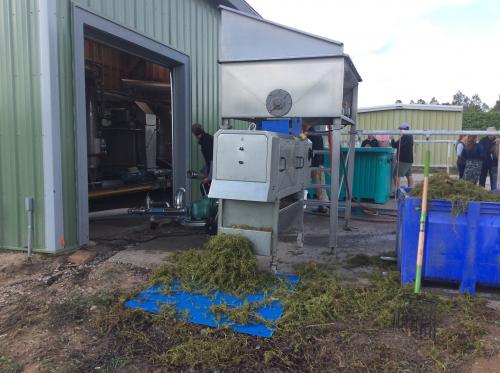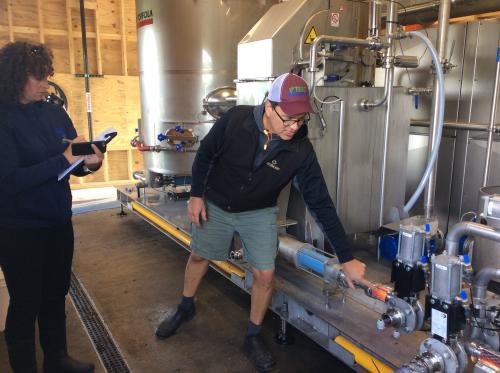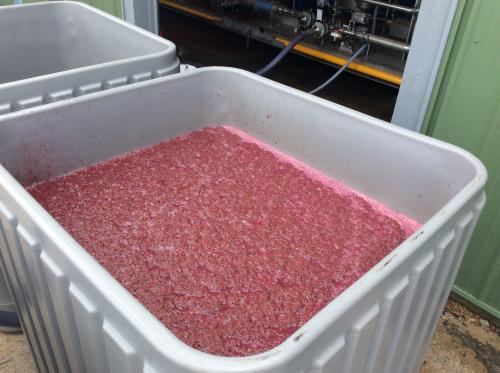Northwest Michigan wine grape report — Oct. 5, 2017
Summary of spotted wing Drosophila activity, harvest status, fruit maturity and innovative thermovinification technology.

Spotted wing Drosophila activity of Leelanau Peninsula and Old Mission Peninsula
Spotted wing Drosophila (SWD) populations typically increase, often exponentially, through the growing season. However, this season we measured clear fluctuations of SWD adults trapped at vineyard centers and borders in all regions of northwest Michigan.
The initial decline of SWD population in vineyards earlier this fall were from traps near north central Old Mission Peninsula; these SWD trap number decreases occurred from Aug. 31 through Sept. 6 (Figs. 1A, B and C). The cause of this early and somewhat unusual population decrease was likely a result of the weather where relatively low temperatures and higher than normal rainfall were recorded (Fig. 2). From Sept. 6–14, SWD populations remained low, again likely due to relatively low average and minimum temperatures.
From Sept. 14–21, there was a considerable increase in the number of total SWD trapped in the south-central Leelanau Peninsula, north-central Leelanau Peninsula and north-central Old Mission Peninsula regions (Figs. 1A, B, C). We attribute the recent SWD increase (second spike) to environmental factors, as we only recorded two rainfall events: 0.19 inch on Sept. 17 and 0.06 inch on Sept. 21. Additionally, minimum temperatures did not drop below 51 degrees Fahrenheit and maximum temperatures did not rise above 85 F, a “sweet spot” in moisture and temperature for SWD population growth according to work in other cropping systems. F
From Sept. 21– 27, we noted a significant decline in SWD numbers across traps in vineyards across northwest Michigan. We attribute this decline to considerably drier conditions with no rainfall and unseasonably warm maximum temperatures. Daytime temperatures soared into the high 80s and low 90s: 89.4 F on Sept. 22, 90.9 on Sept. 23, 91.1 on Sept. 24, 91.2 on Sept. 25 and 89.2 on Sept. 26 (Fig. 2).
The decline in SWD activity is likely caused by high temperatures, and our information is supported by previous reports that found SWD activity decreased when exposed to 86 F, according to Kanzana, 1939. Further research shows that the lethal temperature that kills 50 percent of SWD was 89.6 F, and the upper thermal limit for development was 88.7 F, according to Asplen et al., 2015. There is considerable research activity monitoring SWD population growth in warmer regions of the U.S., such as North Carolina and Florida. We will learn more from these regional researchers about impacts of hot temperatures on SWD. However, we were not anticipating to observe these types of SWD declines at the end of the growing season in northerly northwest Michigan, but again, we did not expect daytime temperatures to hit 90 F in late September.
We will continue to monitor for SWD adults and we will be able to document SWD population activity with the recent warm temperatures and drier conditions during the week of Sept. 27 through Oct. 3. As a general rule, thin-skinned grape varieties are more susceptible to SWD damage than thicker-shinned grape varieties. Keep track of SWD population fluctuations, particularly if they start to rise again and fruit become more susceptible as they ripen.
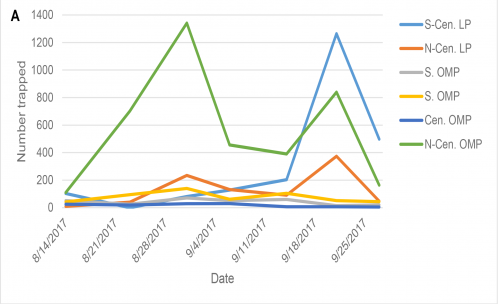
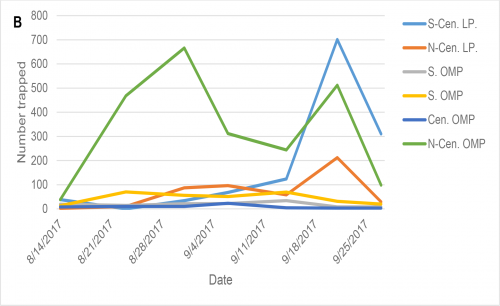
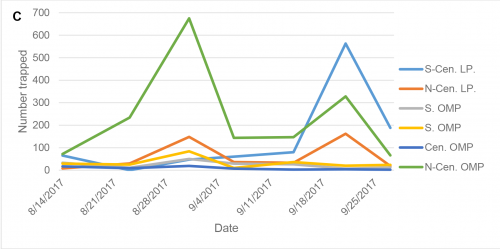
Figure 1. Total (A), male (B) and female (C) SWD trapped at multiple regions in Leelanau Peninsula and Old Mission Peninsula from Aug. 14-Sept. 27, 2017. Regions are as follows: S-Cen. LP = South-Central region of Leelanau Peninsula; N-Cen. LP = North-Central region of Leelanau Peninsula; S. OMP = South region of Old Mission Peninsula; Cen. OMP = Central region of Old Mission Peninsula; N-Cen. OMP = North-Central region of Old Mission Peninsula.
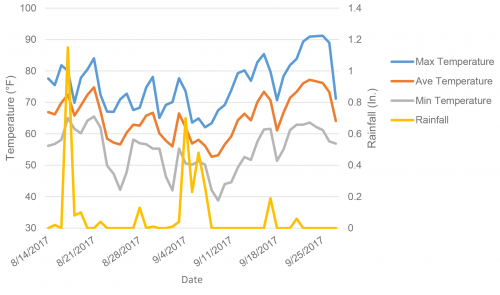
Figure 2. Temperature and rainfall of Old Mission Peninsula from Aug. 14-Sep. 27, 2017. Source: MSU Enviroweather.
Harvest and fruit maturity status of Leelanau Peninsula and Old Mission Peninsula
Harvest of early ripening varieties is underway in northwest Michigan. In the south Old Mission Peninsula, central Old Mission Peninsula and north-central Leelanau Peninsula regions, hybrid varieties such as Cayuga White, Frontenac Gris and La Crescent have been harvested. In south Old Mission Peninsula, we saw Chardonnay, an early ripening Vitis vinifera variety, harvested on Sept. 27 at about 21 degrees brix.
In the south Old Mission Peninsula region, we have been following 100-berry weight (grams) and brix of key V. vinifera varieties including Riesling, Cabernet Franc and Merlot from Sept. 18 through Oct. 3 (Table 1). During this timeframe, the region gained 272 growing degree-days (GDD), an increase from 2,049 to 2,321 GDD. We also documented that 100-berry weight (grams) of Riesling increased from 127 to 161 grams, Cabernet Franc increased from 154 to 165 grams and Merlot increased from 166 to 184 grams (Table 1). During the same time period, brix increased in Riesling from 14.5 to 17.1, Cabernet Franc from 14.2 to 18.0 and Merlot from 15.1 to 19.8.
Communications with vineyard managers in the north-central Leelanau Peninsula indicate Sauvignon Blanc (Photo 1), Chardonnay and Pinot noir are currently at 19.8, 19.7 and 19.9 brix, respectively, and will be harvested within the next 10 days with the aim of achieving 21 brix.
|
Table 1. 100-berry weight, brix and corresponding GDD of three wine grape cultivars located in the south Old Mission Peninsula region in northwest Lower Michigan. |
||||
|---|---|---|---|---|
|
Cultivar |
Sept. 18 (2,049 GDD) |
Oct. 3 (2,321 GDD) |
||
|
100-berry weight (grams) |
Brix |
100-berry weight (grams) |
Brix |
|
|
Riesling |
127 |
14.5 |
161 |
17.0 |
|
Cabernet franc |
154 |
14.2 |
165 |
18.1 |
|
Merlot |
166 |
15.1 |
184 |
19.8 |
Thermovinification technology
Michigan State University Extension was pleased to take part in a notable event on the Leelanau Peninsula on Friday, Sept. 29, as Black Star Farms unveiled their “Flash/Thermo Détente” unit for the first time anywhere in the Midwest U.S. The Flash/Thermo Détente is a piece of equipment that uses an innovative thermovinification technology to incorporate heat and vacuum depressurization into wine to improve color and flavor and reduce harsh flavor compounds.
Although the technology has existed for 20 years with 120 units worldwide, only 12 have been installed in the U.S. This “Flash détente” process (Photos 2, 3 and 4) takes in crushed and de-stemmed grapes, or must (typically of red varieties), and heats them up to 180 F for up to 1 minute. The must then enters a vacuum chamber where grape skin cells are ruptured and they release color constituents that helps extract desirable color components while minimizing harsh tannins that can be distasteful in a finished wine.
With the introduction of the “Flash Détente” unit to the northwest region, wine grape producers and winemakers hope to improve wine quality and flavor and improve returns. We hypothesize that this technology will allow grape producers to produce more consistent tonnage per acre, and winemakers will be able to improve undesirable yet common traits of cool climate-grown grapes. We look forward to working with the wine grape industry on this new and innovative piece of equipment.
Photo 2. Stems of Frontenac gris (bottom) separated from the grapes using a de-stemmer (center), which were then pumped into the Flash Détente unit (left) located on the Leelanau Peninsula of Northwest Michigan.
Photo 3. Lee Lutes of Black Star Farms standing in front of the Flash Détente unit describes the technical aspects of the thermovinification process.
Photo 4. Frontenac gris must pumped into transport vessels after the thermovinification process.



 Print
Print Email
Email